The Effects of Drought in the Huaibei Plain of China Due to Climate Change
Abstract
:1. Introduction
2. Materials and Methods
2.1. Study Area
2.2. Data
2.3. Methodology
2.3.1. General Circulation Model
2.3.2. Downscaling Method
2.3.3. Drought Indices
Standardized Precipitation Index (SPI)
Standardized Precipitation Evapotranspiration Index (SPEI)
2.3.4. Trend Analysis
Mann–Kendall Analysis
Sen’s Slope Estimation
2.3.5. Person Correlation Coefficients
2.3.6. Drought Frequency
3. Results and Discussion
3.1. Applicability Analysis of SPEI
3.2. Spatial Variation of Drought in Baseline and Future Period
3.2.1. Spatial Variation of SPEI in the Baseline Period
3.2.2. Spatial Variation of SPEI in the Future Period
3.3. Temporal Variation of Drought in the Baseline and Future Period
3.3.1. Temporal Variation of SPEI in the Baseline Period
3.3.2. Temporal Variation of SPEI in the Future Period
3.4. Correlation and Trend Analysis of SPI and SPEI
3.4.1. Person Correlation Coefficients
3.4.2. Sen’s Slope Estimation Results
3.5. Discussion
4. Conclusions
- (1)
- In general, SPEI is very suitable for monitoring drought in the Huaibei Plain, which shows the importance of incorporating evapotranspiration data assessment of drought occurrence. Between both periods (baseline and future), more drought events were detected in the future. In future-1, SPEI detected more agricultural droughts than in future-2 and baseline.
- (2)
- Between future and baseline, a Person correlation showed a strong correlation between SPEI in baseline and future periods. The correlation is higher for agricultural drought in future-1 of RCP 4.5
- (3)
- Sen’s Slope trend estimator showed a trend between both periods. SPEI detected a negative and positive trend, as shown in the results.
- (4)
- As the SPEI’s applicability in the Huaibei Plain was examined for the baseline and future periods, it became clear that using the 3 and 6 months SPEI time scale had its own benefits and could monitor regional drought in general and the Huaibei Plain in particular.
Supplementary Materials
Author Contributions
Funding
Conflicts of Interest
References
- Tirivarombo, S.; Osupile, D.; Eliasson, P. Drought monitoring and analysis: Standardised Precipitation Evapotranspiration Index (SPEI) and Standardised Precipitation Index (SPI). Phys. Chem. Earth Parts A/B/C 2018, 106, 1–10. [Google Scholar] [CrossRef]
- Kim, B.S.; Chang, I.G.; Sung, J.H.; Han, H.J. Projection in Future Drought Hazard of South Korea Based on RCP Climate Change Scenario 8.5 Using SPEI. Adv. Meteorol. 2016, 2016, 4148710. [Google Scholar] [CrossRef]
- Kwon, M.; Sung, J.H. Changes in Future Drought with HadGEM2-AO Projections. Water 2019, 11, 312. [Google Scholar] [CrossRef]
- Seneviratne, S.I.; Lehner, I.; Gurtz, J.; Teuling, A.J.; Lang, H.; Moser, U.; Grebner, D.; Menzel, L.; Schroff, K.; Vitvar, T.; et al. Swiss prealpine Rietholzbach research catchment and lysimeter: 32 year time series and 2003 drought event. Water Resour. Res. 2012, 48. [Google Scholar] [CrossRef]
- Hayes, M.J.; Svoboda, M.D.; Wiihite, D.A.; Vanyarkho, O.V. Monitoring the 1996 Drought Using the Standardized Precipitation Index. Bull. Am. Meteorol. Soc. 1999, 80, 429–438. [Google Scholar] [CrossRef]
- Vicente-Serrano, S.M.; Beguería, S.; López-Moreno, J.I. A Multiscalar Drought Index Sensitive to Global Warming: The Standardized Precipitation Evapotranspiration Index. J. Clim. 2010, 23, 1696–1718. [Google Scholar] [CrossRef]
- Zou, X.; Zhai, P.; Zhang, Q. Variations in droughts over China: 1951–2003. Geophys. Res. Lett. 2005, 32. [Google Scholar] [CrossRef]
- Tan, C.; Yang, J.; Li, M. Temporal-Spatial Variation of Drought Indicated by SPI and SPEI in Ningxia Hui Autonomous Region, China. Atmosphere 2015, 6, 1399–1421. [Google Scholar] [CrossRef]
- Palmer, W.C. Meteorological Drought; US Department of Commerce, Weather Bureau: Washington, DC, USA, 1965; Volume 30. [Google Scholar]
- McKee, T.B.; Doesken, N.J.; Kleist, J. The relationship of drought frequency and duration to time scales. In Proceedings of the 8th Conference on Applied Climatology, Boston, MA, USA, 17–22 January 1993. [Google Scholar]
- Anshuka, A.; van Ogtrop, F.F.; Vervoort, R.W. Drought forecasting through statistical models using standardised precipitation index: A systematic review and meta-regression analysis. Nat. Hazards 2019, 97, 955–977. [Google Scholar] [CrossRef]
- Belayneh, A.; Adamowski, J. Drought forecasting using new machine learning methods. J. Water Land Dev. 2013, 18, 3–12. [Google Scholar] [CrossRef]
- Uddin, M.; Eibek, K.U.; Nasrin, Z.M. A comprehensive statistical assessment of drought indices to monitor drought status in Bangladesh. Arab. J. Geosci. 2020, 13, 323. [Google Scholar] [CrossRef]
- Wang, K.-Y.; Li, Q.-F.; Yang, Y.; Zeng, M.; Li, P.-C.; Zhang, J.-X. Analysis of spatio-temporal evolution of droughts in Luanhe River Basin using different drought indices. Water Sci. Eng. 2015, 8, 282–290. [Google Scholar] [CrossRef]
- Oki, T.; Kanae, S.J. Global hydrological cycles and world water resources. Science 2006, 313, 1068–1072. [Google Scholar] [CrossRef] [PubMed]
- Gurrapu, S.; Chipanshi, A.; Sauchyn, D. Comparison of the SPI and SPEI on predicting drought conditions and streamflow in the Canadian prairies. In Proceedings of the 28th Conference on Hydrology, Atlanta, GA, USA, 2–6 February 2014; American Meteorological Society: Atlanta, GA, USA, 2014. [Google Scholar]
- Jasim, A.I.; Awchi, T.A. Regional meteorological drought assessment in Iraq. Arab. J. Geosci. 2020, 13, 284. [Google Scholar] [CrossRef]
- Svoboda, M.D.; Fuchs, B.A. Handbook of Drought Indicators and Indices; World Meteorological Organization: Geneva, Switzerland, 2016. [Google Scholar]
- Zhai, J.; Su, B.; Krysanova, V.; Vetter, T.; Gao, C.; Jiang, T. Spatial Variation and Trends in PDSI and SPI Indices and Their Relation to Streamflow in 10 Large Regions of China. J. Clim. 2010, 23, 649–663. [Google Scholar] [CrossRef]
- Vicente-Serrano, S.M.; Beguería, S.; Lorenzo-Lacruz, J.; Camarero, J.J.; Lopez-Moreno, I.; Azorin-Molina, C.; Revuelto, J.; Morán-Tejeda, E.; Sanchez-Lorenzo, A. Performance of Drought Indices for Ecological, Agricultural, and Hydrological Applications. Earth Interact. 2012, 16, 1–27. [Google Scholar] [CrossRef]
- Nedealcov, M.; Răileanu, V.; Sîrbu, R.; Cojocari, R. The Use Of Standardized Indicators (SPI And SPEI) In Predicting Droughts Over The Republic Of Moldova Territory. Present Environ. Sustain. Dev. 2015, 9, 149–158. [Google Scholar] [CrossRef]
- Yang, Q.; Li, M.; Zheng, Z.; Ma, Z. Regional applicability of seven meteorological drought indices in China. Sci. China Earth Sci. 2017, 60, 745–760. [Google Scholar] [CrossRef]
- Liu, X.; Zhu, X.; Pan, Y.; Bai, J.; Li, S. Performance of different drought indices for agriculture drought in the North China Plain. J. Arid. Land 2018, 10, 507–516. [Google Scholar] [CrossRef]
- Qaisrani, Z.N.; Nuthammachot, N.; Techato, K. Drought monitoring based on Standardized Precipitation Index and Standardized Precipitation Evapotranspiration Index in the arid zone of Balochistan province, Pakistan. Arab. J. Geosci. 2021, 14, 11. [Google Scholar] [CrossRef]
- Rascón, J.; Angeles, W.G.; Huatangari, L.Q.; Oliva, M.; Gurbillón, M.B. Dry and Wet Events in Andean Populations of Northern Peru: A Case Study of Chachapoyas, Peru. Front. Environ. Sci. 2021, 9, 54. [Google Scholar] [CrossRef]
- Chen, M.; Ning, S.; Cui, Y.; Jin, J.; Zhou, Y.; Wu, C. Quantitative Assessment and Diagnosis for Regional Agricultural Drought Resilience Based on Set Pair Analysis and Connection Entropy. Entropy 2019, 21, 373. [Google Scholar] [CrossRef] [PubMed]
- Wei, Y.; Jin, J.; Jiang, S.; Ning, S.; Cui, Y.; Zhou, Y. Simulated Assessment of Summer Maize Drought Loss Sensitivity in Huaibei Plain, China. Agronomy 2019, 9, 78. [Google Scholar] [CrossRef]
- Yuan, H.; Cui, Y.; Ning, S.; Jiang, S.; Yuan, X.; Tang, G. Estimation of maize evapotraspiration under drought stress-A case study of Huaibei Plain, China. PLoS ONE 2019, 14, e0223756. [Google Scholar] [CrossRef] [PubMed]
- Chen, M.; Ning, S.; Jin, J.; Cui, Y.; Wu, C.; Zhou, Y. Risk Assessment of Agricultural Drought Disaster on the Huaibei Plain of China Based on the Improved Connection Number and Entropy Information Diffusion Method. Water 2020, 12, 1089. [Google Scholar] [CrossRef]
- Gou, Q.; Zhu, Y.; Horton, R.; Lü, H.; Wang, Z.; Su, J.; Cui, C.; Zhang, H.; Wang, X.; Zheng, J.; et al. Effect of climate change on the contribution of groundwater to the root zone of winter wheat in the Huaibei Plain of China. Agric. Water Manag. 2020, 240, 106292. [Google Scholar] [CrossRef]
- Zhu, Y.; Ren, L.; Lü, H.; Drake, S.; Yu, Z.; Wang, Z.; Fang, X.; Yuan, F. Effect of Water Table Depth on Growth and Yield of Soybean Yudou 16. J. Hydrol. Eng. 2013, 18, 1070–1076. [Google Scholar] [CrossRef]
- Zhu, Y.; Ren, L.; Horton, R.; Lü, H.; Chen, X.; Jia, Y.; Wang, Z.; Sudicky, E.A. Estimating the contribution of groundwater to rootzone soil moisture. Hydrol. Res. 2013, 44, 1102–1113. [Google Scholar] [CrossRef]
- Gou, Q.; Zhu, Y.; Lü, H.; Horton, R.; Yu, X.; Zhang, H.; Wang, X.; Su, J.; Liu, E.; Ding, Z.; et al. Application of an improved spatio-temporal identification method of flash droughts. J. Hydrol. 2022, 604, 127224. [Google Scholar] [CrossRef]
- Pachauri, R.; Meyer, L. Climate Change 2014: Synthesis Report. Contribution of Working Groups I, II and III to the Fifth Assessment Report of the Intergovernmental Panel on Climate Change; IPCC: Geneva, Switzerland, 2014. [Google Scholar]
- Baek, H.-J.; Lee, J.; Lee, H.-S.; Hyun, Y.-K.; Cho, C.; Kwon, W.-T.; Marzin, C.; Gan, S.-Y.; Kim, M.-J.; Choi, D.-H.; et al. Climate change in the 21st century simulated by HadGEM2-AO under representative concentration pathways. Asia Pac. J. Atmos. Sci. 2013, 49, 603–618. [Google Scholar] [CrossRef]
- Panofsky, H.A.; Brier, G.W. Some Applications of Statistics to Meteorology; Earth and Mineral Sciences Continuing Education; College of Earth and Mineral Sciences: Philadelphia, PA, USA, 1968. [Google Scholar]
- Wood, A.; Leung, L.R.; Sridhar, V.; Lettenmaier, D.P. Hydrologic Implications of Dynamical and Statistical Approaches to Downscaling Climate Model Outputs. Clim. Change 2004, 62, 189–216. [Google Scholar] [CrossRef]
- Piani, C.; Haerter, J.O.; Coppola, E. Statistical bias correction for daily precipitation in regional climate models over Europe. Theor. Appl. Clim. 2010, 99, 187–192. [Google Scholar] [CrossRef]
- Cannon, A.J.; Sobie, S.R.; Murdock, T.Q. Bias Correction of GCM Precipitation by Quantile Mapping: How Well Do Methods Preserve Changes in Quantiles and Extremes? J. Clim. 2015, 28, 6938–6959. [Google Scholar] [CrossRef]
- Li, W.; Duan, L.; Wang, W.; Wu, Y.; Liu, T.; Quan, Q.; Chen, X.; Yin, H.; Zhou, Q. Spatiotemporal characteristics of drought in a semi-arid grassland over the past 56 years based on the Standardized Precipitation Index. Meteorol. Atmos. Phys. 2021, 133, 41–54. [Google Scholar] [CrossRef]
- Thornthwaite, C.W. An Approach toward a Rational Classification of Climate. Geogr. Rev. 1948, 38, 55–94. [Google Scholar] [CrossRef]
- Hargreaves, G.H. Defining and using reference evapotranspiration. J. Irrig. Drain. Eng. 1994, 120, 1132–1139. [Google Scholar] [CrossRef]
- Li, W.-G.; Yi, X.; Hou, M.-T.; Chen, H.-L.; Chen, Z.-L. Standardized precipitation evapotranspiration index shows drought trends in China. Chin. J. Eco-Agric. 2012, 20, 643–649. [Google Scholar] [CrossRef]
- Li, Y.; Wang, Z.; Zhang, Y.; Li, X.; Huang, W. Drought variability at various timescales over Yunnan Province, China: 1961–2015. Theor. Appl. Clim. 2019, 138, 743–757. [Google Scholar] [CrossRef]
- Yue, S.; Pilon, P.; Cavadias, G.J. Power of the Mann–Kendall and Spearman’s rho tests for detecting monotonic trends in hydrological series. J. Hydrol. 2002, 259, 254–271. [Google Scholar] [CrossRef]
- Gocic, M.; Trajkovic, S. Change, Analysis of changes in meteorological variables using Mann-Kendall and Sen’s slope estimator statistical tests in Serbia. Glob. Planet. Chang. 2013, 100, 172–182. [Google Scholar] [CrossRef]
- Kendall, M.G. Rank Correlation Methods. 1948. Available online: https://scirp.org/reference/ReferencesPapers.aspx?ReferenceID=2275550 (accessed on 20 March 2023).
- Sen, P.K. Estimates of the regression coefficient based on Kendall’s tau. J. Am. Stat. Assoc. 1968, 63, 1379–1389. [Google Scholar] [CrossRef]
- Drápela, K.; Drápelová, B. Application of Mann-Kendall test and the Sen’s slope estimates for trend detection in deposition data from Bílý Kříž (Beskydy Mts., the Czech Republic) 1997–2010. Beskydy 2011, 4, 133–146. [Google Scholar]
- Yang, L.; Tian, J.; Fu, Y.; Zhu, B.; He, X.; Gao, M.; Odamtten, M.T.; Kong, R.; Zhang, Z. Will the arid and semi-arid regions of Northwest China become warmer and wetter based on CMIP6 models? Hydrol. Res. 2022, 53, 29–50. [Google Scholar] [CrossRef]
- Vicente-Serrano, S.M.; Chura, O.; López-Moreno, J.I.; Azorin-Molina, C.; Sanchez-Lorenzo, A.; Aguilar, E.; Moran-Tejeda, E.; Trujillo, F.; Martínez, R.; Nieto, J.J. Spatio-temporal variability of droughts in Bolivia: 1955–2012. Int. J. Clim. 2015, 35, 3024–3040. [Google Scholar] [CrossRef]
- Labudová, L.; Labuda, M.; Takáč, J. Comparison of SPI and SPEI applicability for drought impact assessment on crop production in the Danubian Lowland and the East Slovakian Lowland. Theor. Appl. Clim. 2017, 128, 491–506. [Google Scholar] [CrossRef]
- Huang, J.; Xue, Y.; Sun, S.; Zhang, J. Spatial and temporal variability of drought during 1960–2012 in Inner Mongolia, north China. Quat. Int. 2015, 355, 134–144. [Google Scholar] [CrossRef]

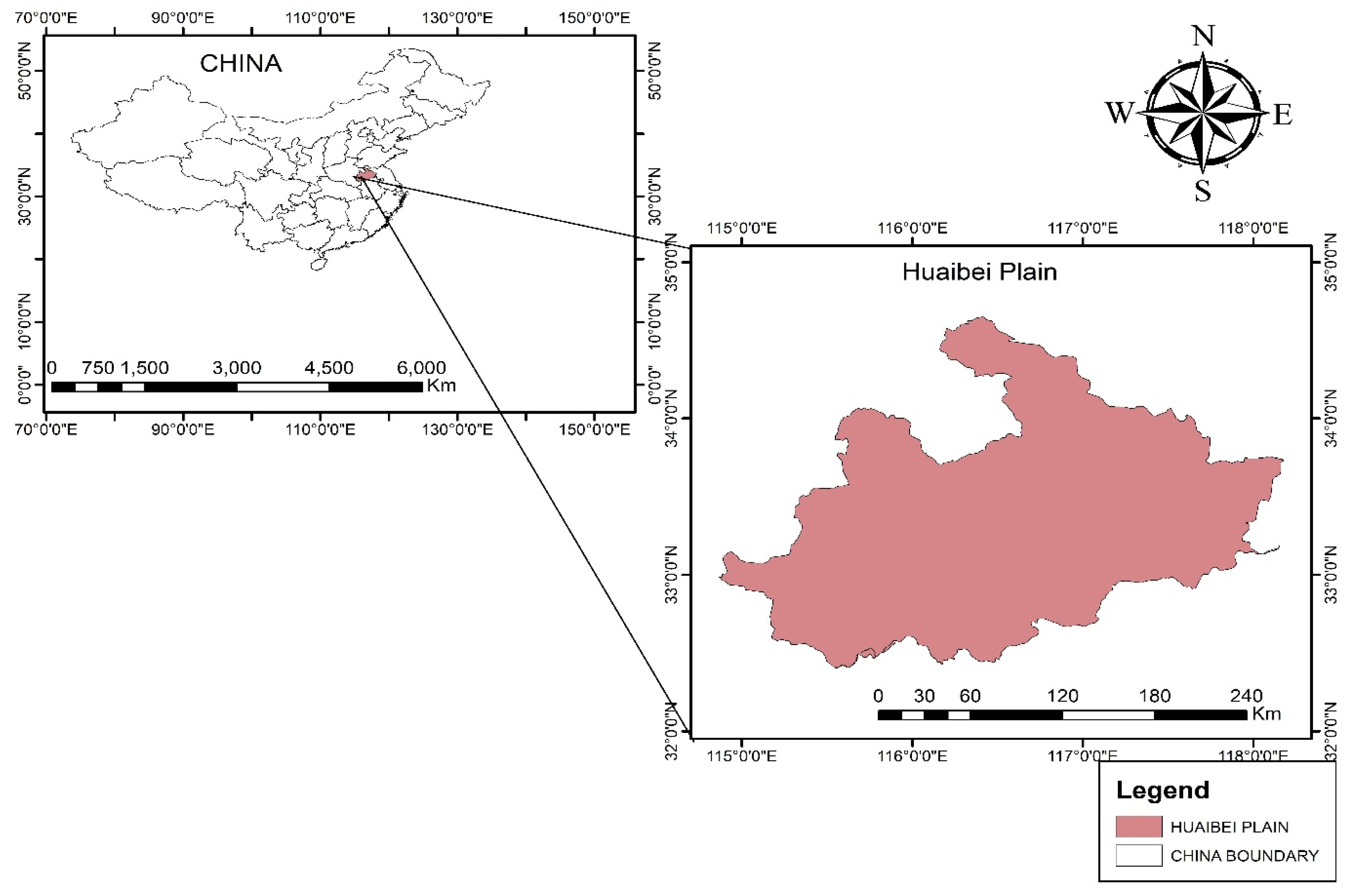
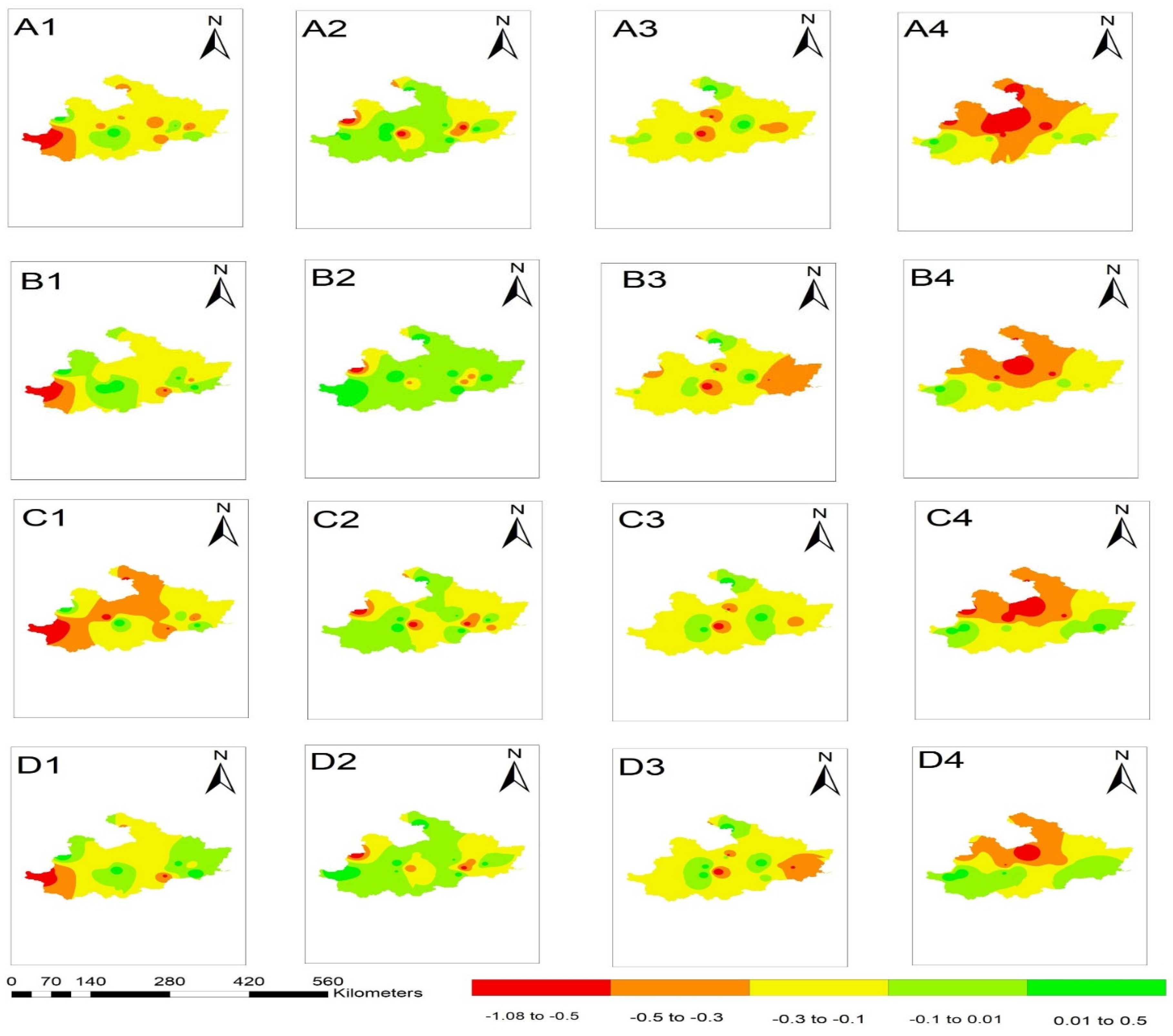

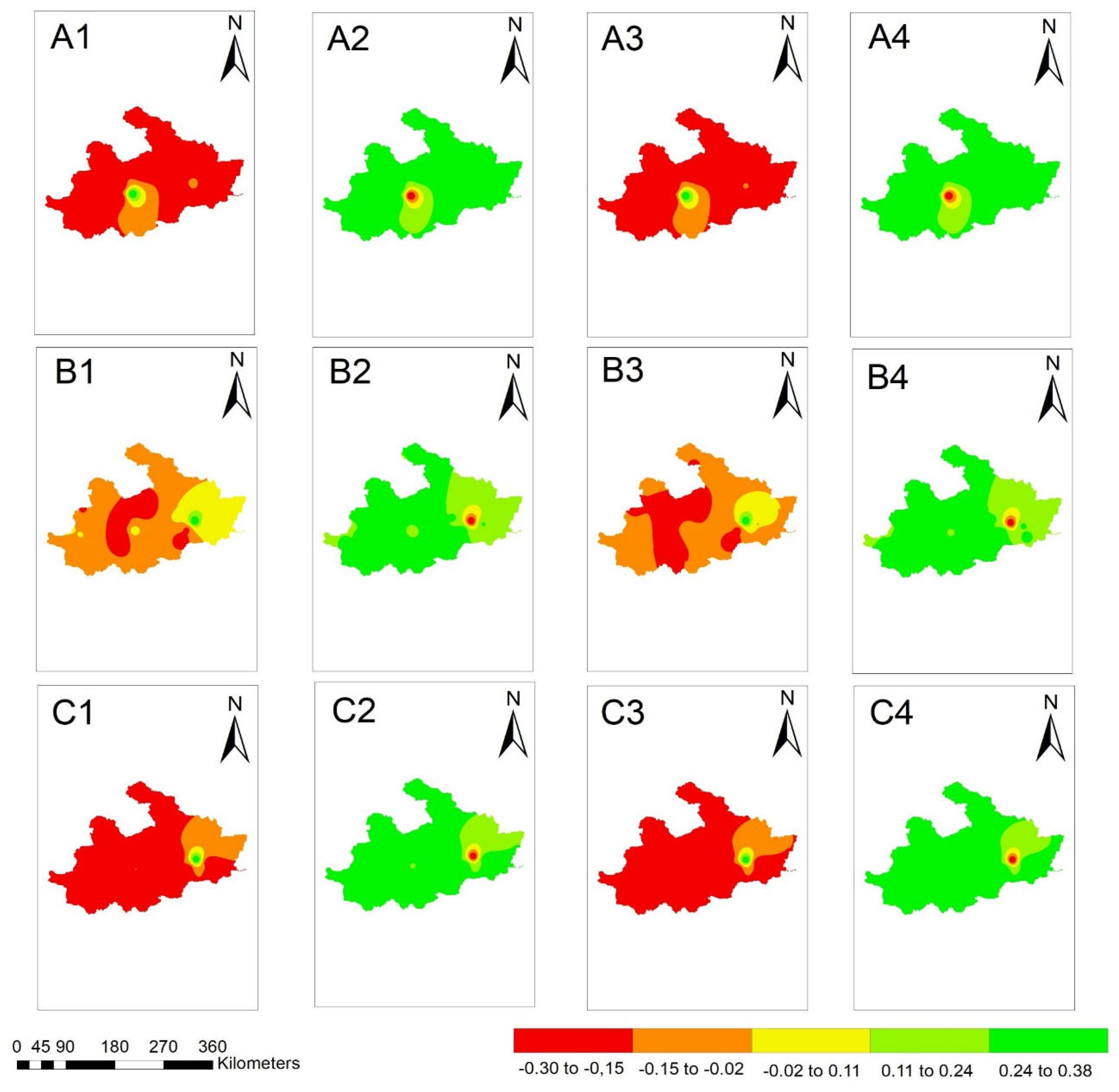
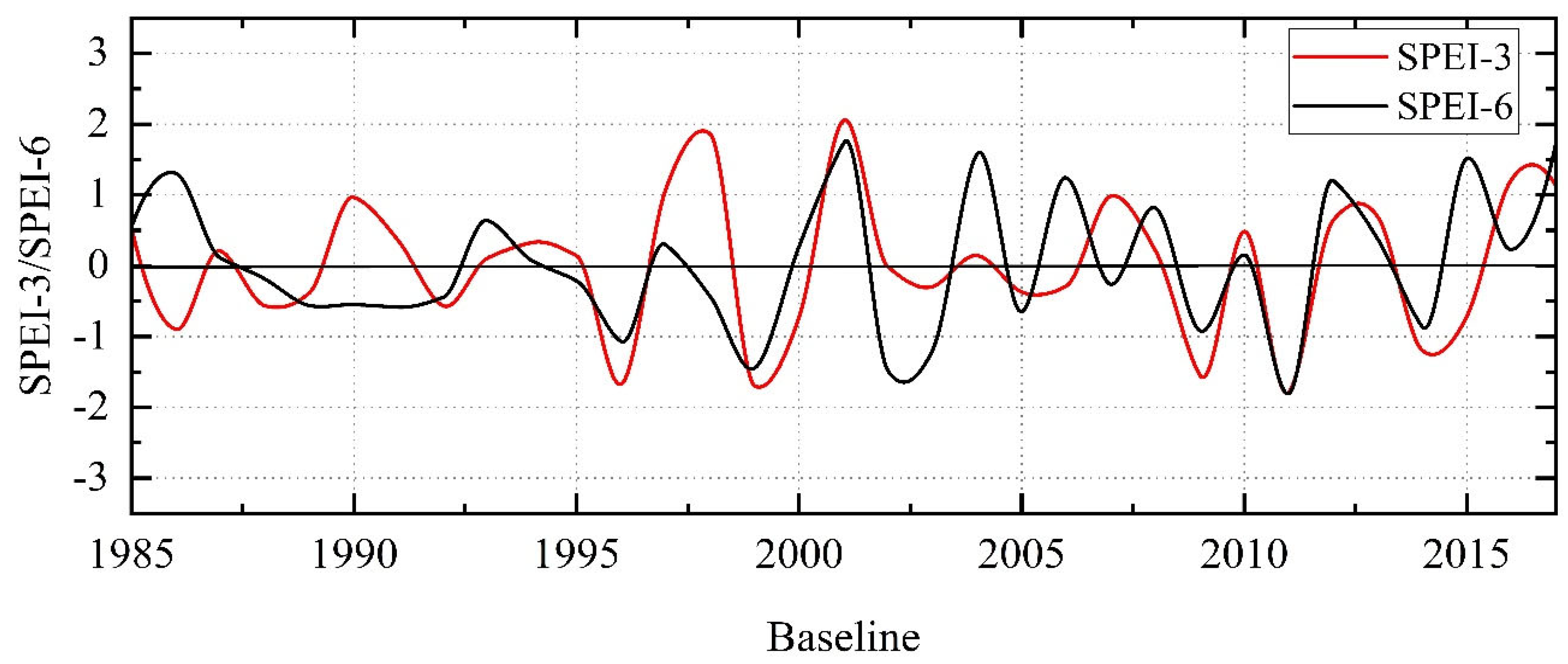

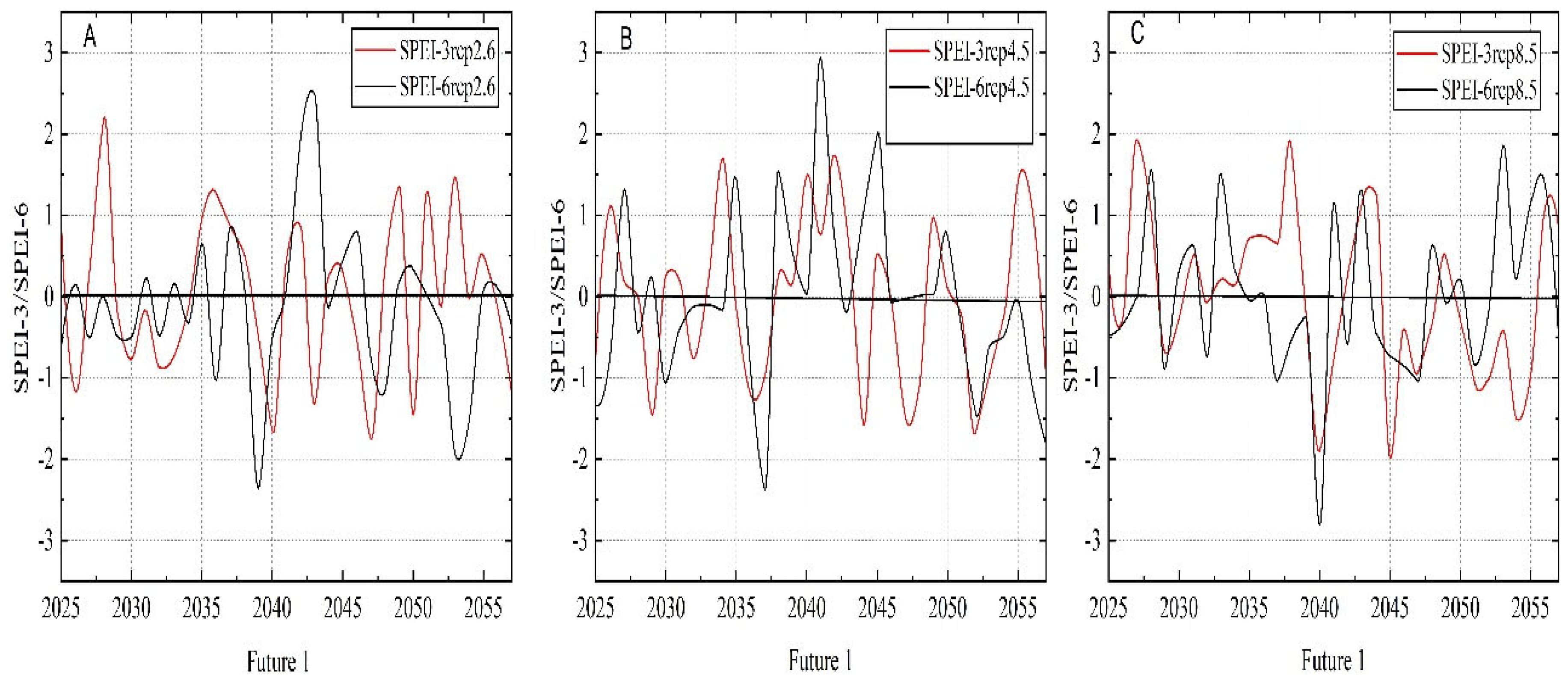


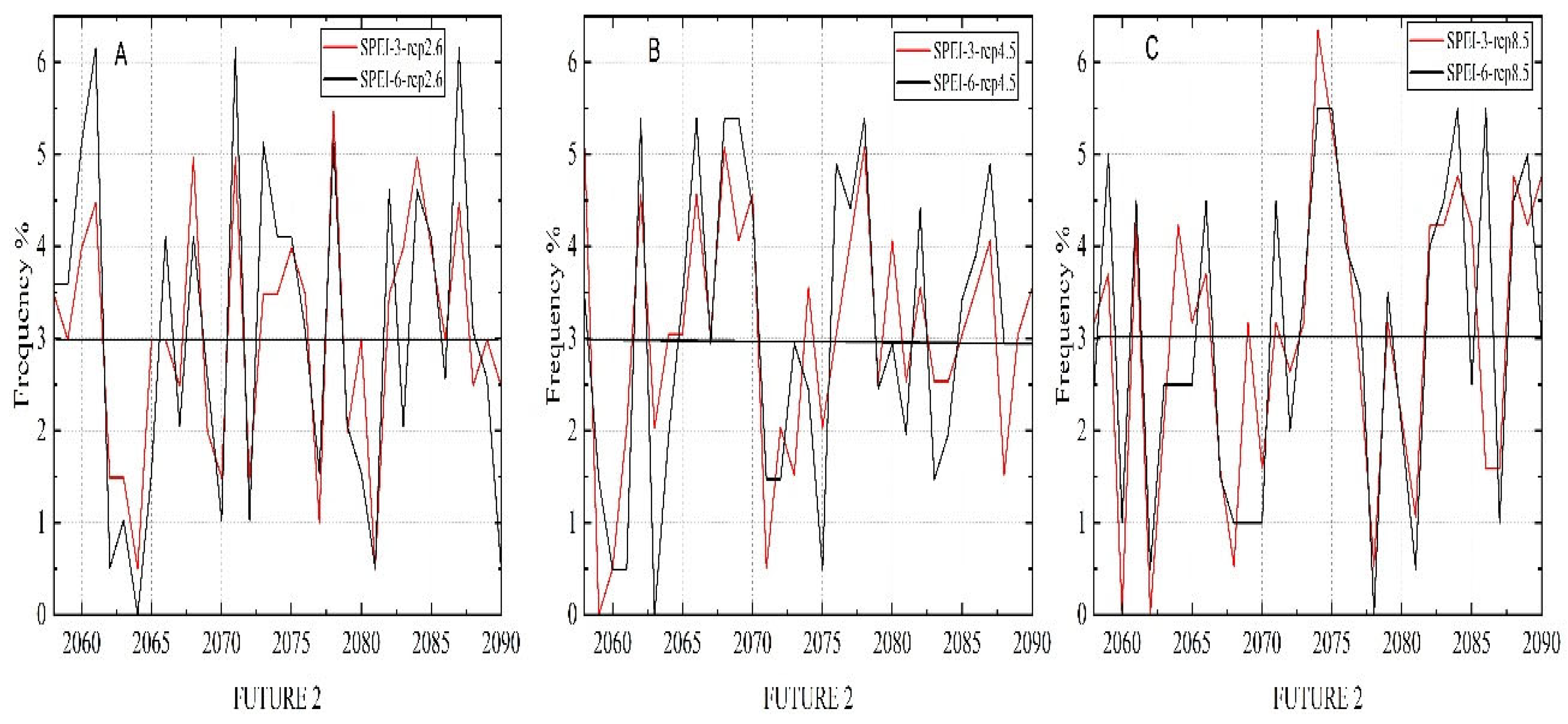
| SPI/SPEI Values | Categories |
|---|---|
| ≥2.00 | Extremely wet |
| 1.50 to 1.99 | Very wet |
| 1.00 to 1.49 | Moderately wet |
| − 0.99 to 0.99 | Normal |
| −1 to −1.49 | Moderate drought |
| −1.50 to −1.99 | Severe drought |
| ≤−2.00 | Extreme drought |
| Num | Start-End Date | Duration (Days) | Drought Area (%) |
|---|---|---|---|
| 1 | 2001/08/05 to 2001/10/16 | 72 days | 59.9% |
| 2 | 2002/03/30 to 2002/06/18 | 80 days | 49.2% |
| 3 | 2009/08/13 to 2009/10/24 | 72 days | 37.9% |
| 4 | 2012/04/06 to 2012/08/26 | 80 days | 63.7% |
| Periods | Observed | 2.6 F1 | 2.6 F2 | 4.5 F1 | 4.5 F2 | 8.5 F1 | 8.5 F2 |
|---|---|---|---|---|---|---|---|
| SPEI 3 and 6 | 0.69 | 0.63 | 0.63 | 0.72 | 0.68 | 0.66 | 0.69 |
| Baseline (1985–2017) | RCP 2.6 Future-1/Future-2 | RCP 4.5 Future-1/Future-2 | RCP 8.5 Future-1/Future-2 |
|---|---|---|---|
| −0.0001 | − 0.0003/0.0001 | −0.0017/−0.0005 | −0.0007/−0.0017 |
| 0.0002 | 0.0008/0.0001 | −0.0018/−0.0008 | 0.0003/−0.0013 |
Disclaimer/Publisher’s Note: The statements, opinions and data contained in all publications are solely those of the individual author(s) and contributor(s) and not of MDPI and/or the editor(s). MDPI and/or the editor(s) disclaim responsibility for any injury to people or property resulting from any ideas, methods, instructions or products referred to in the content. |
© 2023 by the authors. Licensee MDPI, Basel, Switzerland. This article is an open access article distributed under the terms and conditions of the Creative Commons Attribution (CC BY) license (https://creativecommons.org/licenses/by/4.0/).
Share and Cite
Badji, O.; Zhu, Y.; Lü, H.; Guédé, K.G.; Chen, T.; Oumarou, A.; Yao, K.B.M.O.; Brice, S. The Effects of Drought in the Huaibei Plain of China Due to Climate Change. Atmosphere 2023, 14, 860. https://doi.org/10.3390/atmos14050860
Badji O, Zhu Y, Lü H, Guédé KG, Chen T, Oumarou A, Yao KBMO, Brice S. The Effects of Drought in the Huaibei Plain of China Due to Climate Change. Atmosphere. 2023; 14(5):860. https://doi.org/10.3390/atmos14050860
Chicago/Turabian StyleBadji, Ousmane, Yonghua Zhu, Haishen Lü, Kanon Guédet Guédé, Tingxing Chen, Abdoulaye Oumarou, Kouassi Bienvenue Mikael Onan Yao, and Sika Brice. 2023. "The Effects of Drought in the Huaibei Plain of China Due to Climate Change" Atmosphere 14, no. 5: 860. https://doi.org/10.3390/atmos14050860
APA StyleBadji, O., Zhu, Y., Lü, H., Guédé, K. G., Chen, T., Oumarou, A., Yao, K. B. M. O., & Brice, S. (2023). The Effects of Drought in the Huaibei Plain of China Due to Climate Change. Atmosphere, 14(5), 860. https://doi.org/10.3390/atmos14050860







